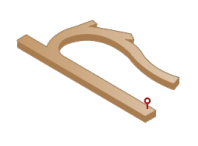Race type - Flat
Epsom Downs
Course details
Racing on Epsom Downs dates back to the time of Charles II but it took a further century before the great race it is associated with was conceived.

GUIDE - For Racecourse
Left-handed, U-shaped circuit of 1m4f, chute for 5f races
Racing on Epsom Downs dates back to the time of Charles II but it took a further century before the great race it is associated with was conceived. We're talking about the 'Derby' of course which was named after the Earl of Derby, who won the right to name the race on the single toss of a coin with close friend Sir Charles Bunbury. Ironically, the inaugural race in 1780 was won by the three-year-old colt Diomed, a horse owned by Bunbury. A year earlier had seen the first running of the 'Oaks' (for three-year-old fillies) and the two races now spearhead the Derby Festival Meeting which takes place every June. With the Downs being designated a public area, entry to the centre of the course is free and this encourages huge crowds many of whom watch the action from the vantage point of a double decker bus. The more well to do, on the other hand, frequent the grandstand area where a morning suit and top hat is mandatory. The Queen never misses a Derby, arriving courtesy of the Royal Train, making Epsom a real melting pot for all social classes.
Track / Draw Bias
In races on the round course, those runners that are drawn low are favoured as they are able to grab a good position against the rail and go the shortest way round. This is particularly so in races over 6f, 7f and 1m when the going is riding fast. When the going is on the soft side, jockeys tend to make a beeline for the better ground up the stands' rail, which is a result of the way the course cambers towards the centre. In 5f races, the stalls are placed on the stands' side and those horses drawn low against the rail have a definite edge. Only the real fast starters can overcome a high draw.
Principal Races
The vast majority of prize money at the Surrey venue is crammed into the two-day meeting in June with a massive chunk going towards the Derby, which will have a prize fund of at least £1.25m in 2012. That makes it by far the richest race run it Britain, not to mention the great prestige that goes with it, and a lucrative career at stud awaits the winner. The race is the middle leg of the English 'Triple Crown', with the first leg being the 2000 Guineas and the last being the St Leger, although it's rare for the Derby winner to go for the St Leger these days with more lucrative races abroad, like the Arc, on the agenda. It used to be run midweek on a Wednesday but is now staged on a Saturday, with the Oaks taking place on the Friday along with the Coronation Cup, which is run over 1m4f and is open to horses aged four or older. These three Group 1 contests are accompanied by a couple of Group 3s in the Diomed Stakes and Princess Elizabeth Stakes.

Course Characteristics
The course is like nothing else in the world and provides both horses and jockeys with a unique test. Think of the letter U lying on its side with the open end to the right of the grandstand. The track itself measures 1m4f in length with a home straight of over three and a half furlongs. At the end of the home straight there is a chute which provides the start for 5f races. Nothing too unusual so far but it's the courses undulations that make it so unusual and horses in 1m4f races in particular have to cope with several changes of elevation. The most severe of these is at around the seven and a half furlong point, which coincides with a sharp left-hand turn. The drop here is approximately ninety feet over a distance of three and a half furlongs and the runners then have to navigate another sharp left-handed turn, known as Tattenham Corner, before they swing into the home straight. Not every horse can cope with such a test and the speed horses are travelling at tends to throw some of the bigger-topped horses off balance. Needless to say, it's a real course specialists track and favours those horses that can hold a prominent position but still have enough stamina in reserve for the business end of the race. The straight 5f course is virtually all downhill and that makes it the fastest sprint course in the world.
Top Trainers
Competitive racing ensures the races are shared out equally with no one trainer dominating, although it's worth mentioning the impressive strike rate of Saeed Bin Suroor, with around 33% of his runners being led into the winner's enclosure in the last five seasons. Better still is the 47% strike rate of Sir Mark Prescott who doesn't have the ammunition Godolphin has but places his runners superbly. Richard Hannon, Mark Johnston and Andrew Balding are three other trainers with a knack of training winners here.
Top Jockeys
Top jockeys on fancied horses is always a killer combo and that's certainly the case here. Still, it's worth picking out some names and few ride the track better than Ryan Moore, who has produced some epic performances here down the years, not least his winning ride on Snow Fairy in the 2010 Oaks. Of the rest, Tom Queally, Richard Hughes, Neil Callan and Jamie Spencer should continue to pay their way, and look out also for Silvestre De Sousa who rode three winners here in 2011 when based up north and will have more winning opportunities now he's riding for Godolphin.
